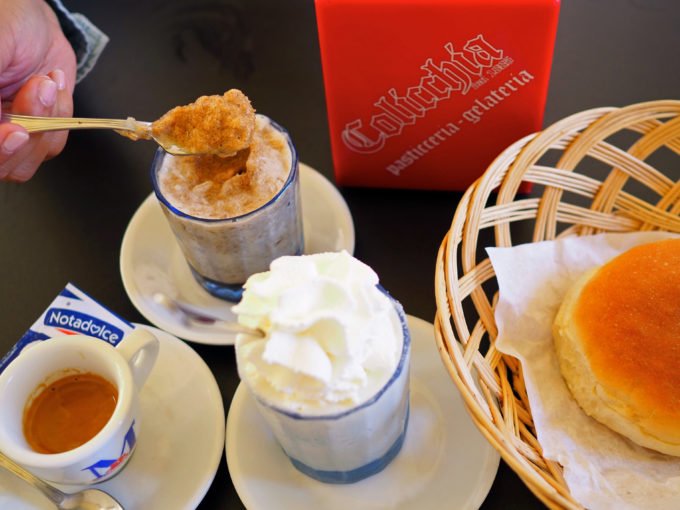
Do Not Question Strange Breakfasts, Submit to Them

Do Not Question Strange Breakfasts, Submit to Them
Granitas in Trapani
On a sleepy side street in the city of Trapani, western Sicily’s millennia-old trading and tuna hub, lies granita mecca Antica Colicchia Pasticceria Gelateria. Outside, electrical wires haphazardly draped over picturesque balconies share space with ornate tiles, laundry set out to dry, hanging flowers, and tiny satellite dishes beaming soccer matches and Tunisian music videos to those inside.
An old Mediterranean Phoenician trading port that lies closer—both geographically and culturally—to North Africa than it does to mainland Italy, Trapani has retained parts of its unique Arab character and reliance on the sea for thousands of years. Short ferries to Tunis continue the cultural, economic, and historical ties between Trapani and the Arab world today. This is a city, in Italy, that favors couscous over pasta.
Trapani’s undisputed granita king since 1885, Antica Colicchia Pasticceria Gelateria serves, perhaps, Sicily’s best granitas to a mix of local families, workers, and tourists looking for a typical Sicilian breakfast to cool down with on the narrow souk-like streets of Trapani’s old city.
Granitas are a resolutely Sicilian tradition that can be eaten throughout the day as a dessert, a palate cleanser, or a refreshing semi-icy treat. Most frequently, however, they are consumed for breakfast alongside a warm brioche and a shot of espresso.
Outside the tiny old café, sounds of a drill waft from down the block as restorations of this grand old city’s buildings, badly damaged from allied WWII bombings, continue seventy years after the end of the war.
Like many other things in Sicily, including the food, architecture, and people, the granita has a fascinating migratory history that originates from the varied civilizations that have come to this island since the 11th century BC and then not wanted to leave.
Historians believe that the Arabs that ruled Sicily in the 9th century conceived of the first granitas here by scaling Mt. Etna’s volcanic peak to bring down fresh snow, mixing it with sugar and the island’s bright local ingredients. The brioche served alongside most likely came from the Normans who made their way from France in the 11th century to build on the advancements of the Arabs and make Sicily one of the most flourishing, dynamic, and multi-cultural places in the world while the rest of Europe remained largely in the dark.
At Antica Colicchia Pasticceria Gelateria in Trapani, the granitas are prepared roughly the same way in 2016. Fresh local almonds, lemons, espresso, blood oranges, or pistachios are finely mixed with sugar and hand-shaved ice that retains its glorious snow-like consistency. Served out of a glass with a tiny ornate silver square spoon, there is nothing artificial here. Just three ingredients—water, sugar, and natural nuts, fruits, or flowers (jasmine granitas are a Trapanese specialty)—that’s it.
It’s 10 am and as our almond and espresso granitas slowly melt into a delicious breakfast soup mopped up by the fresh-baked brioche, a rotund man in an Italian soccer jersey eating gelato out of an oversized ice cream cone walks by pushing a shopping cart filled with bricks. Across the street three priests are lighting sticks on fire outside of a Baroque church.
There is something slightly absurd about eating a magical slush-like creation, essentially an early form of ice cream, for breakfast. But in Sicily, the absurd takes on a poetic quality seeped in a history equal parts glorious and tragic that simply makes sense. When half the city is waking up and doing the same, and has been for more than a thousand years, one must not question the granita. One must submit to it. Every morning.